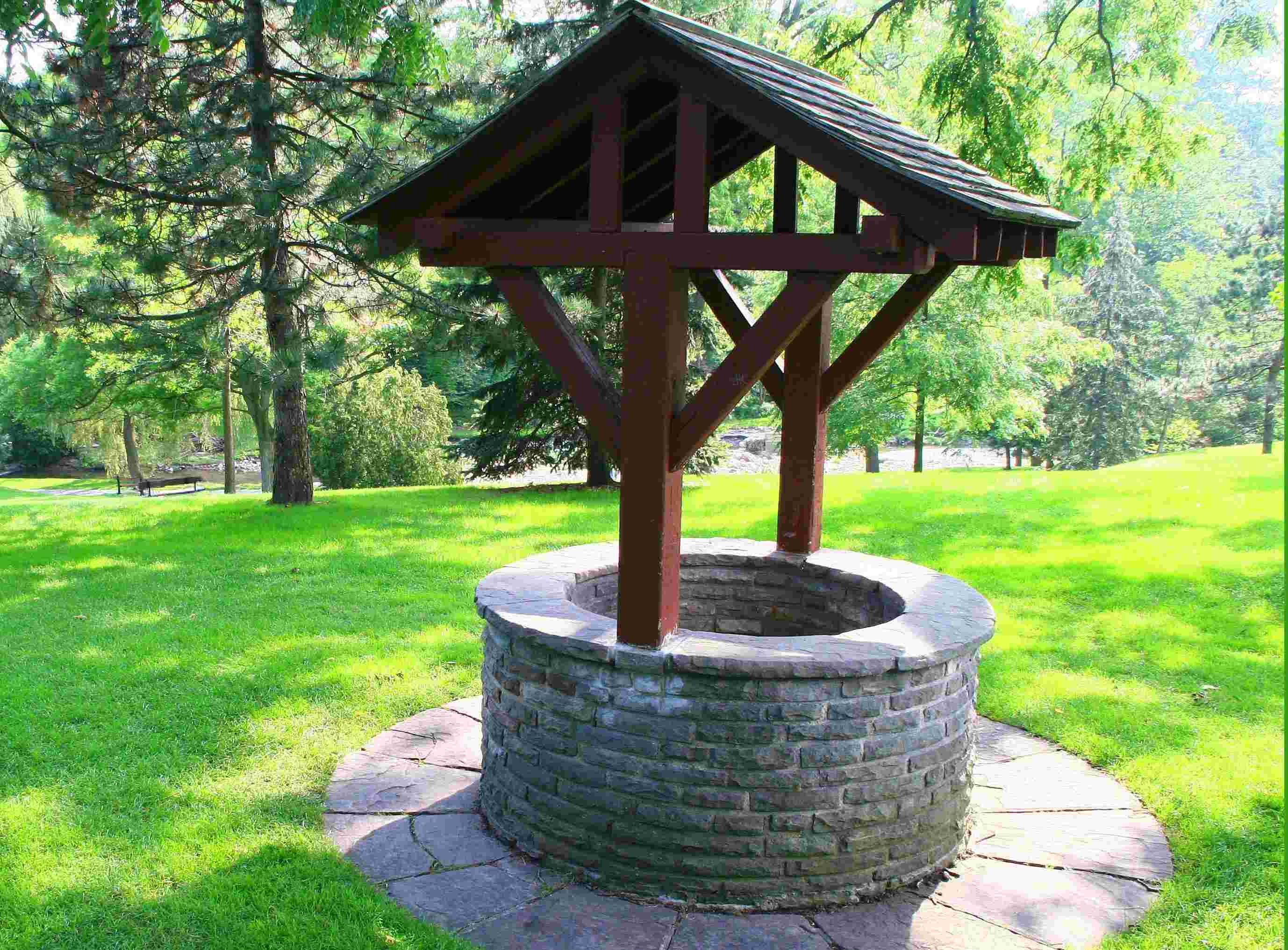Home>Gardening Techniques>DIY Projects>How To Drill A Well In Your Backyard


DIY Projects
How To Drill A Well In Your Backyard
Modified: February 9, 2024
Learn how to drill your own well in your backyard with this step-by-step guide to DIY projects. Start saving money and having a reliable water source today!
(Many of the links in this article redirect to a specific reviewed product. Your purchase of these products through affiliate links helps to generate commission for Chicagolandgardening.com, at no extra cost. Learn more)
Table of Contents
- Introduction
- Step 1: Determine Permit and Legal Requirements
- Step 2: Choose the Location for the Well
- Step 3: Gather the Necessary Tools and Equipment
- Step 4: Call for Utility Locates
- Step 5: Mark the Location and Prepare the Drilling Site
- Step 6: Drill the Well
- Step 7: Install the Casing and Screen
- Step 8: Conduct Well Development and Testing
- Step 9: Install the Well Cap and Cover
- Step 10: Properly Dispose of Drilling Waste
- Step 11: Test the Water Quality
- Step 12: Maintain and Service the Well
- Conclusion
Introduction
Have you ever considered drilling a well in your backyard? It may seem like a daunting task, but with the right knowledge and tools, it is actually a feasible DIY project. Drilling a well can provide you with a self-sufficient and sustainable source of water, making it an attractive option for homeowners looking to reduce their reliance on public water systems.
In this comprehensive guide, we will walk you through the step-by-step process of drilling a well in your backyard. From obtaining the necessary permits to testing the water quality, we will cover everything you need to know to successfully complete this project.
Before you get started, it’s important to note that drilling a well is not suitable for every property. Factors such as soil composition, proximity to underground utilities, and local regulations can impact the feasibility of drilling a well. Therefore, it’s crucial to conduct thorough research and consult with professionals before proceeding.
Additionally, drilling a well requires specialized equipment and can be physically demanding. If you don’t have the necessary experience or equipment, it’s recommended to hire a professional well drilling contractor. However, if you’re up for the challenge and confident in your DIY skills, let’s dive into the process of drilling a well in your backyard.
Step 1: Determine Permit and Legal Requirements
Before embarking on your well-drilling project, it’s important to understand and comply with the permit and legal requirements in your area. Regulations regarding well drilling vary from one jurisdiction to another, so it’s crucial to do your due diligence and obtain the necessary permits.
Contact your local municipal or county office to inquire about the requirements for drilling a well. They will provide you with information about the permits you need to acquire and any specific regulations that need to be followed. Some areas may require a drilling permit or a water well contractor’s license, while others may have restrictions on well depth or location.
It’s important to note that drilling a well without the proper permits can result in fines or even legal repercussions. By ensuring compliance with the regulations, you not only protect yourself legally but also guarantee the safety and quality of your well.
Additionally, it’s worth investigating any potential restrictions or considerations specific to your property. For instance, if you live in a subdivision or a community with a homeowners’ association, there may be additional guidelines you need to adhere to.
Once you have a clear understanding of the permit and legal requirements, gather all the necessary documentation and prepare to submit your application. Depending on your jurisdiction, you may need to provide detailed information about the well’s location, drilling methods, and proposed water usage.
Remember to keep a copy of all permits and approvals you receive throughout the drilling process. These documents will be essential for future reference, inspections, and potential property transactions.
By taking the time to determine and fulfill the permit and legal requirements, you ensure that your well-drilling project proceeds smoothly and within the bounds of the law. Now that you’re equipped with the necessary knowledge, let’s move on to the next step: choosing the location for your well.
Step 2: Choose the Location for the Well
Choosing the right location for your well is crucial for its functionality and longevity. Several factors need to be considered when selecting the optimal spot for drilling.
First and foremost, you need to determine the water source on your property. Conducting a hydrogeological study can help identify potential aquifers and the depth at which water can be accessed. Consulting with a professional hydrogeologist can provide valuable insights into the groundwater availability and quality in your area.
Another important consideration is the distance from potential sources of contamination. It’s essential to avoid locations near septic systems, livestock areas, or chemical storage facilities. These sources can introduce pollutants into the groundwater, compromising the quality of the water from your well.
Accessibility is also a key factor to consider. The well should be located in an area where drilling equipment can easily access, ensuring a smooth and efficient drilling process. Additionally, access to power sources is necessary for operating drilling machinery and testing equipment.
Pay attention to the topography of your property. Locate the well at the highest point possible to prevent surface water runoff from entering the well. This will help maintain water quality and reduce the risk of contamination.
Lastly, consider the future maintenance and servicing needs of the well. You want to ensure that there is enough space around the wellhead for routine inspections, repairs, and any necessary equipment installations.
Once you have taken all these factors into account, mark the chosen location and verify that it meets all the necessary requirements set by your local governing body. With the location chosen, you’re now ready to move on to the next step: gathering the necessary tools and equipment.
Step 3: Gather the Necessary Tools and Equipment
Before you begin drilling your well, it’s essential to gather all the necessary tools and equipment to ensure a smooth and efficient operation. Having the right tools at hand will save you time and effort throughout the drilling process.
Here is a list of essential tools and equipment you will need:
- Drilling Rig: This is the primary equipment for drilling the well. Depending on the depth and diameter of the well, you can choose from various types of drilling rigs, including truck-mounted, trailer-mounted, or portable options. Consider renting or purchasing a drilling rig that meets your specific needs.
- Drill Bits: You will need a variety of drill bits to penetrate different types of soil and rock formations. Common drill bits include drag bits, tri-cone bits, and PDC bits. Ensure that you have a sufficient supply of drill bits in different sizes.
- Casing Materials: Casing is used to protect the well hole and prevent it from collapsing. Depending on local regulations, you may need specific types and sizes of casing, such as PVC or steel. Ensure that you have adequate lengths of casing material on hand.
- Drill Pipe: Drill pipe is used to connect the drilling bit to the drilling rig and allows for the removal of drilling cuttings. Make sure you have enough drill pipe sections to reach the desired well depth.
- Water Pump: A water pump is necessary to circulate drilling fluid (or mud) during the drilling process. This fluid helps cool the drill bit and remove cuttings. Choose a pump with enough capacity to handle the desired flow rate.
- Well Development Tools: These tools are used to clean and develop the well after drilling. They include bailers, surge blocks, and air lift pumps. Having the appropriate well development tools will ensure the well reaches optimal productivity.
- Other Miscellaneous Tools: Don’t forget to gather other essential tools such as wrenches, hammers, pliers, and safety equipment like goggles and gloves. These tools will assist you in various tasks throughout the drilling process.
It’s crucial to ensure that all tools and equipment are in good working condition. Regular maintenance and inspection of the drilling rig and other mechanical components are necessary to prevent breakdowns and delays during drilling.
Consider renting any specialized equipment that you may not use frequently to save costs. Many equipment rental companies offer a wide range of drilling and well-related tools that can be a cost-effective solution.
With all the necessary tools and equipment assembled, you’re now ready to move on to the next step: calling for utility locates to ensure a safe drilling process.
Step 4: Call for Utility Locates
Prior to drilling your well, it is crucial to call for utility locates to prevent any potential damage or accidents during the drilling process. Utility locates help identify the underground utility lines on your property, ensuring that you do not accidentally drill into them.
Contact your local utility companies or a utility locating service to request a utility locate. Provide them with the necessary information about your property and the location of the planned well. The utility companies will then send a representative to your property to mark the underground utility lines.
It is important to give the utility companies ample notice, as this process can take several days to complete. This will allow the utilities to locate and mark their lines accurately, preventing any potential disruptions or damages.
Once the utility lines are marked, pay close attention to the markings and take note of their locations. This information is crucial during the drilling process to ensure that you avoid drilling in areas where utility lines are present.
During the drilling process, it’s essential to exercise caution and stay aware of the marked utility lines. Be mindful of their locations as you operate the drilling equipment to prevent any accidental damage.
Remember, damaging utility lines can lead to disruptions in services, potential safety hazards, and expensive repairs. By taking the time to call for utility locates, you minimize the risk of encountering any issues and ensure a safe drilling process.
With the utility locates marked and confirmed, you are now ready to move on to the next step: marking the location and preparing the drilling site.
Step 5: Mark the Location and Prepare the Drilling Site
Once you have obtained the necessary permits and utility locates, it’s time to mark the location and prepare the drilling site for the well. Proper preparation ensures a safe and efficient drilling process and helps maintain the integrity of the well and surrounding area.
Here are the steps to mark the location and prepare the drilling site:
- Clear the Area: Remove any vegetation, rocks, or debris from the drilling site to provide a clean and accessible area for drilling. Clearing the area also helps prevent any interference with the drilling equipment.
- Mark the Location: Use stakes or flags to mark the exact location of the well. Take into consideration any setback requirements from property lines, buildings, or other structures. This ensures that the well is drilled in the desired position.
- Set Up Safety Barriers: Erect safety barriers around the drilling site to control access and keep bystanders safe. Drilling can create vibrations and noise, so it’s important to keep people at a safe distance during the operation.
- Prepare Water Supply: Ensure that you have a reliable water supply available for drilling operations. This can be a nearby water source or a holding tank that can provide sufficient water for the drilling process.
- Set up Equipment: Position the drilling rig and other necessary equipment in the designated location. Make sure that there is enough space for the rig to operate effectively and that it is stable and properly secured.
- Secure Perimeter: Establish a perimeter around the drilling site to prevent unauthorized access. Post signs indicating that a drilling operation is in progress and prohibit entry to unauthorized personnel.
As you prepare the drilling site, it’s important to follow all safety protocols. Wear appropriate personal protective equipment, such as hard hats, safety glasses, and steel-toed boots. Adhere to any local regulations regarding site preparation and safety measures.
Preparing the drilling site sets the foundation for a successful well-drilling process. With the location marked and the site ready, you are now ready to proceed with the drilling process itself. This will be covered in the next step.
Step 6: Drill the Well
Now that you have completed the necessary preparations, it’s time to start drilling your well. This step involves the actual process of penetrating the ground and creating a hole for accessing the underground water source.
Follow these steps to drill your well:
- Set Up the Drilling Rig: Ensure that the drilling rig is properly set up and securely anchored. Make sure all connections and mechanisms are in place and functioning correctly.
- Start Drilling: Begin drilling using the appropriate drill bit for the soil or rock type. Adjust the drilling speed and pressure according to the resistance encountered. Monitor the drilling process closely for any signs of deviation or complications.
- Remove Cuttings: As you drill, periodically withdraw the drill bit to remove the cuttings and prevent clogging. This can be done using the drill pipe, bailers, or other suitable techniques depending on the drilling method being used.
- Continue Drilling to Desired Depth: Drill the well to the desired depth, which may be determined by factors such as water availability and local regulations. Keep track of the depth by using measuring instruments and recording the progress accurately.
- Monitor Well Conditions: Throughout the drilling process, pay attention to the drilling fluid circulation, pressure, and any changes in soil or rock formations. Regularly inspect the drilled material for any signs of water or other anomalies.
- Take Necessary Breaks: Take periodic breaks as needed to allow the drilling equipment to cool down, prevent overheating, and ensure continued efficient operation.
Drilling a well is a complex and time-consuming process that requires expertise and patience. It’s essential to follow all safety protocols, adhere to local regulations, and consult professional resources if needed.
Remember to document the drilling process, including the depth reached, any rock formations encountered, and any other noteworthy observations. This documentation will be valuable for future reference and potential maintenance or troubleshooting needs.
Once you have drilled the well to the desired depth, you are ready to move on to the next step: installing the casing and screen.
Step 7: Install the Casing and Screen
After drilling the well, the next step is to install the casing and screen. The casing provides stability and prevents the walls of the well from caving in, while the screen allows water to flow into the well while keeping out debris and sediment.
Here are the key steps to installing the casing and screen:
- Choose the Right Casing: Select casing material that meets local regulations and matches the depth and diameter of your well. Common materials include PVC, steel, or concrete. Ensure that the casing is corrosion-resistant and will withstand the geological conditions in your area.
- Prepare the Well: Clear the well of any drilling debris and ensure it is clean and free from obstructions. Use a brush or other suitable tools to remove excess drilling mud or loose sediment from the well walls.
- Lower the Casing: Carefully lower the casing into the well, ensuring that it is fully vertical and properly aligned. Use a casing driver or mallet to gently tap the casing down as needed. Take caution not to damage the casing or the well walls during this process.
- Secure the Casing: Secure the casing in place by sealing it with a bentonite seal or grout to prevent the infiltration of surface water or contaminants. Follow the manufacturer’s instructions for the specific casing material you are using.
- Install the Screen: Position the screen inside the casing, ensuring that it is properly sized and will allow water to flow into the well while filtering out sediment and debris. The screen should be securely attached to the casing to prevent displacement.
- Test the Well: Conduct a preliminary test of the well’s pumping capacity to ensure the screen is properly functioning and to remove any remaining debris from the drilling process.
Proper installation of the casing and screen is essential for the long-term functionality and efficiency of your well. Pay attention to the manufacturer’s recommendations and any local regulations to ensure compliance with the required specifications.
As you install the casing and screen, keep detailed records of the installation process, including any measurements, materials used, and any observations or challenges encountered. These records will prove valuable for future reference and maintenance needs.
With the casing and screen successfully installed, you are now ready for the next step: conducting well development and testing.
Step 8: Conduct Well Development and Testing
Once the casing and screen are installed, the next crucial step is to conduct well development and testing. This process helps ensure optimal water flow and quality from your newly drilled well.
Here are the key steps involved in well development and testing:
- Develop the Well: Well development is the process of removing any drilling mud, sediment, and debris that may have accumulated during the drilling and casing installation. This can be done by pumping water vigorously from the well to flush out impurities.
- Purge the Well: Purging the well involves pumping a significant volume of water from the well to remove any stagnant water, sediment, or air pockets. This helps in achieving a stable water flow and prevents contamination.
- Conduct Well Yield Test: A well yield test measures the flow rate of the well and determines its water supply capacity. This is done by pumping water from the well at a constant rate and measuring the amount of water produced over a set period. The test helps assess the well’s efficiency and performance.
- Perform Water Quality Testing: It is crucial to test the water quality of your well to ensure it is safe for consumption. Water samples should be collected and analyzed by a certified laboratory to check for any potential contaminants or issues.
- Document the Results: Throughout the development and testing process, keep detailed records of the activities conducted, the test results, and any observations made. This documentation will serve as valuable reference material for future well maintenance, troubleshooting, and regulatory compliance.
Well development and testing are essential to ensure that your well is functioning optimally and providing clean water. It is recommended to consult with a professional well driller or water expert to guide you through this process accurately.
Take note of any specific regulations in your area regarding well testing and water quality. It is important to comply with these requirements to ensure the safety and integrity of your well.
Once the well development and testing are completed, you can proceed to the next step: installing the well cap and cover.
Step 9: Install the Well Cap and Cover
The installation of a well cap and cover is an important step in securing and protecting your well. These components help prevent contaminants from entering the well, ensure the safety of the water supply, and safeguard against any physical damage.
Here are the key steps to follow when installing the well cap and cover:
- Select the Well Cap and Cover: Choose a well cap and cover that is suitable for your well and complies with local regulations. Well caps are usually made of durable materials such as plastic or metal and are designed to provide a secure seal.
- Clean the Wellhead: Before installing the well cap, clean the wellhead area to remove any dirt, debris, or other materials that may interfere with the installation or compromise the seal.
- Position and Secure the Well Cap: Place the well cap over the wellhead, ensuring a proper fit and alignment. Fasten the cap securely to the well casing using the appropriate screws or bolts according to the manufacturer’s instructions.
- Install the Vent: Some well caps have a vent that allows air to circulate in the well. If your well cap includes a vent, ensure it is properly installed and positioned to provide adequate ventilation while preventing the entry of contaminants.
- Attach the Cover: Install a durable cover over the well cap to protect it from the elements and physical damage. The cover can be made of materials such as concrete, plastic, or metal. Ensure it is securely anchored and provides easy access for maintenance and inspections.
- Label the Well: Affix a clear and visible label on the well cap or cover indicating that it is a well and that unauthorized access is prohibited. This helps prevent accidental tampering and ensures compliance with safety regulations.
Proper installation of the well cap and cover is vital for maintaining the integrity and safety of your well. A secure cap and well cover protect against contamination, unauthorized access, and potential accidents.
Regularly inspect the well cap and cover for any signs of wear, damage, or deterioration. Replace any worn-out or malfunctioning components promptly to prevent the entry of contaminants and to maintain the effectiveness of the well protection system.
With the well cap and cover installed, you are now ready to move on to the next step: properly disposing of drilling waste.
Step 10: Properly Dispose of Drilling Waste
During the well drilling process, it is important to properly manage and dispose of the drilling waste to minimize environmental impact and comply with regulations.
Here are some guidelines to follow when disposing of drilling waste:
- Separate Waste Materials: Segregate the drilling waste into different categories such as cuttings, drilling fluids, and other waste materials. This makes it easier to manage and dispose of each type appropriately.
- Reuse or Recycle if Possible: Whenever possible, consider reusing or recycling the drilling waste. For example, some drilling fluids can be treated and reused in future drilling projects. Explore recycling options for materials such as metal or plastic containers.
- Hire Licensed Waste Disposal Services: If you are unable to recycle or reuse the waste, hire licensed waste management companies to handle the disposal. These professionals have the knowledge and equipment to dispose of the waste in an environmentally responsible manner.
- Follow Local Regulations: Research and comply with local regulations regarding the proper disposal of drilling waste. Regulations may vary depending on your location, so ensure that you are aware of any specific requirements or restrictions.
- Prevent Soil and Water Contamination: Take precautions to prevent drilling waste from contaminating the soil or nearby water sources. Avoid disposing of waste in sensitive areas such as wetlands or water bodies. Follow best practices for containment and containment methods to minimize the risk of pollution.
- Document the Disposal Process: Keep records of the disposal process, including receipts or certificates from waste disposal services. This documentation acts as proof of proper waste management, which may be required for regulatory compliance or future property transactions.
Proper disposal of drilling waste not only protects the environment but also ensures compliance with regulations and demonstrates responsible drilling practices. Taking the time to manage waste effectively contributes to the overall sustainability and integrity of your well project.
With the drilling waste properly disposed of, you can now move on to the next step: testing the water quality from your well.
Step 11: Test the Water Quality
Testing the water quality from your well is a crucial step to ensure the safety and suitability of the water for consumption. Water quality testing provides valuable insights into the presence of contaminants and allows you to take necessary actions to maintain the purity of your water supply.
Here are the key steps to testing the water quality:
- Collect Water Samples: Follow proper sampling procedures to collect representative water samples from your well. This involves using sterile containers and following any specific instructions provided by the testing laboratory.
- Choose an Accredited Laboratory: Select a reputable and accredited laboratory to conduct the water quality analysis. Look for laboratories that specialize in testing well water or are certified by relevant regulatory agencies.
- Specify the Testing Parameters: Determine the specific parameters you want to test for based on local regulations and any specific concerns related to your area. Common parameters include bacteria, pH levels, minerals, heavy metals, and potentially harmful chemicals.
- Submit the Samples and Request the Test: Package the water samples according to the laboratory’s instructions and submit them along with the requested tests. Provide any relevant information about the well location, drilling details, and any potential contamination sources.
- Review the Test Results: Once the testing is complete, review the test results provided by the laboratory. Look for any abnormalities or levels of contaminants that exceed the recommended standards or guidelines.
- Take Necessary Actions: If the test results indicate any water quality issues, consult with a water treatment professional or a local health department for guidance on appropriate remedial actions. This may involve installing water treatment systems, addressing potential contamination sources, or taking preventative measures to ensure safe drinking water.
Regular water quality testing is essential for maintaining the safety and quality of your well water. It is recommended to establish a routine schedule for testing, such as annually or as advised by local health authorities.
Keep a record of all water quality test results, including the parameters tested, the dates of testing, and any actions taken in response to the results. This documentation will help you track any changes in water quality over time and facilitate future discussions with water experts or regulatory authorities.
With the water quality tested and any necessary actions taken, you are now ready for the final step of maintaining and servicing your well.
Step 12: Maintain and Service the Well
Maintaining and servicing your well is essential to ensure its longevity, efficiency, and the continued availability of clean water. Regular maintenance and periodic servicing help detect and address any issues before they become more significant problems.
Here are the key steps to maintain and service your well:
- Establish a Maintenance Schedule: Create a regular maintenance schedule for your well, including tasks such as inspecting the wellhead, checking the well cap and cover, monitoring water levels, and conducting water quality tests. Follow the recommendations provided by regulatory agencies or consult with a well service professional.
- Inspect the Wellhead: Regularly inspect the wellhead for any signs of damage or wear. Check for cracks in the casing, loose fittings, or any visible leaks. Ensure that the well cap and cover are secure and intact.
- Monitor Water Levels: Keep track of the water levels in your well to detect any significant changes. Unusual variations in water levels may indicate issues such as depletion, structural problems, or contamination. Consult with a well professional if you notice any abnormal changes.
- Test Water Quality: Continue to test the water quality periodically, even after the initial testing. Regular testing helps monitor any changes in water quality and ensures the ongoing safety of your water supply.
- Address Maintenance Issues Promptly: If you notice any maintenance or performance issues during your inspections, address them promptly. This may include repairing leaks, replacing damaged components, or scheduling professional servicing as needed.
- Consult with Professionals: Engage a professional well service company or pump contractor for periodic servicing, especially for more complex tasks such as pump inspections, disinfection, or major repairs. These professionals have the expertise and equipment to handle more specialized maintenance tasks.
- Keep Records: Maintain thorough records of all maintenance activities, including dates, tasks performed, test results, and any repairs or servicing carried out. These records help track the maintenance history of your well and provide valuable information in case of future issues or property transactions.
Regular maintenance and servicing of your well are essential to ensure its proper functioning and longevity. By investing time and effort in well maintenance, you can enjoy a reliable and continuous supply of clean water for years to come.
It is also important to stay updated on any changes in regulations or advancements in well maintenance practices. This can help you adapt your maintenance routine to best practices and ensure compliance with current guidelines.
With proper maintenance and servicing completed, you have successfully completed the process of drilling and maintaining a well in your backyard. Congratulations on taking this self-sufficient and sustainable step towards water independence!
Conclusion
Drilling a well in your backyard can be a rewarding and worthwhile DIY project. It provides you with a self-sufficient and sustainable source of water, reducing your dependence on public water systems. By following the step-by-step process outlined in this guide, you can successfully drill a well and ensure its functionality, efficiency, and safety.
From determining permit and legal requirements to installing the well cap and cover, each step is crucial to the overall success of your well-drilling project. Obtaining the necessary permits, choosing the right location, gathering the required tools and equipment, and following proper drilling techniques are essential for a smooth and efficient operation.
Throughout the process, it is important to remain aware of safety protocols, comply with local regulations, and consult professionals when necessary. Regular maintenance, water quality testing, and prompt addressing of issues are key to maintaining the longevity and performance of your well.
Remember, drilling a well is not suitable for every property, and it is crucial to conduct thorough research and consult with professionals before proceeding. If you do not have the necessary experience or tools, it may be best to hire a professional well drilling contractor to ensure the job is done correctly.
By successfully drilling a well in your backyard, you gain the advantages of self-sufficiency, cost savings, and environmental sustainability. Access to your own clean water source provides peace of mind, especially during times of water scarcity or emergencies.
Make sure to keep records of all permits, tests, maintenance activities, and any repairs or servicing carried out. These records serve as a valuable reference for future maintenance needs or property transactions.
Congratulations on taking the initiative to drill a well in your backyard! Enjoy the benefits of a reliable and sustainable water supply for years to come.










